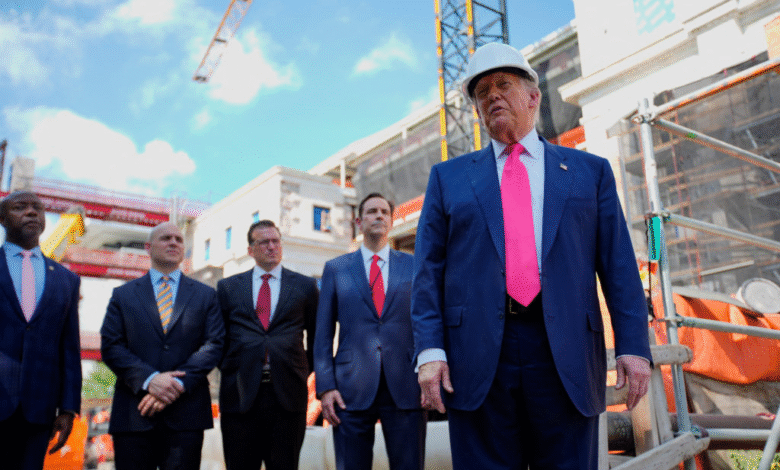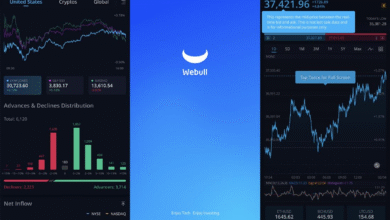Federal Reserve Interest Rates Held Steady Amid Trump Critique

Federal Reserve interest rates play a crucial role in shaping the economic landscape, influencing everything from consumer loans to business investments. On Wednesday, the Federal Open Market Committee surprised many by opting to keep the federal funds rate unchanged at a range of 4.25%-4.5%, defying pressures from President Trump, who has frequently criticized the Fed’s reluctance to implement aggressive cuts. Despite dissent from two governors advocating for immediate easing, the central bank’s decision reflects a cautious stance amid evolving economic data. As markets anticipated no change, this vote marks a notable division within the Fed, reminding us of the complex dynamics at play in determining monetary policy. Looking ahead, interest rate cut expectations are fueling speculation about upcoming Federal Reserve meetings and the implications for economic growth, particularly if conditions shift in a way that necessitates a different approach.
In the realm of monetary policy, the interest adjustments made by the Federal Reserve have significant implications for overall economic health. Recently, the central bank decided to maintain its benchmark borrowing rate, a development that has drawn both support and criticism from various political figures. President Trump’s vocal discontent with the Fed’s approach has brought renewed attention to how such decisions affect financial markets and economic stability. Amid discussions of potential interest rate cuts, analysts are watching closely for signals from the Fed that could indicate a shift in strategy at future meetings. Understanding these economic indicators is essential for grasping the broader implications of monetary policy on growth and inflation.
Understanding the Federal Reserve’s Decision to Maintain Interest Rates
The Federal Reserve’s recent decision to maintain interest rates steady at a range of 4.25%-4.5% underscores its commitment to carefully evaluate economic conditions. This decision, reached by the Federal Open Market Committee with a vote of 9-2, reflects a cautious stance amidst mixed signals from economic indicators. Maintaining the status quo is significant as it not only impacts overnight lending rates between banks but also influences consumer loans, mortgages, and broader economic activity. By choosing not to alter rates, the Fed aims to balance the need for economic growth while keeping inflation in check.
Central bankers are tasked with navigating complex economic landscapes, and the decision to hold rates firm was not without controversy. Governors Michelle Bowman and Christopher Waller expressed dissent, advocating for a more accommodative approach in light of easing inflation trends and signs of potential labor market weakness. This division within the Fed is noteworthy, as it’s rare to see such resistance from multiple governors on a key decision. The disparity may signal differing perspectives on how to interpret current economic data and the future trajectory of growth.
Implications of Trump’s Criticism on Federal Reserve Policy
President Donald Trump’s vocal criticism of the Federal Reserve has introduced a political dimension to central banking, which is traditionally seen as an autonomous institution. Trump’s push for aggressive interest rate cuts has created tension, as he has suggested that lowering rates significantly could stimulate economic growth and mitigate the burden of national debt. However, such pressure raises concerns about the integrity of the Fed’s independence, which is crucial for maintaining the credibility of monetary policy. The divergence of opinions between the White House and Fed officials emphasizes the delicate balance between political influence and economic decision-making.
Despite Trump’s assertions, the Fed has resisted calls for substantial cuts, highlighting a fundamental disagreement in economic philosophy. By adhering to its mandate, the Fed seeks to make decisions based on empirical data rather than political persuasion. This conflict may challenge the Fed’s public image, as ongoing criticism from the administration threatens to undermine confidence in its decision-making processes. Nevertheless, the Fed remains focused on assessing inflation and growth metrics, prioritizing economic stability over political expediency.
Expectations for Future Interest Rate Cuts
The anticipation of future interest rate cuts by the Federal Reserve has become a central topic among investors and market analysts. Following their recent meeting, market sentiment suggests that many traders expect a shift in policy direction as early as September. The backdrop of a 3% growth rate reported in the second quarter, along with moderating inflation, intensifies discussions surrounding potential rate adjustments. Financial markets closely monitor Fed communications for hints at the central bank’s readiness to pivot towards easing.
Increasing expectations of rate cuts also reflect broader economic conditions that may necessitate intervention. As the labor market shows signs of softening and inflation moves closer to the Fed’s 2% target, the central bank may interpret this as an opportunity to spur growth through lower borrowing costs. However, Fed Chair Jerome Powell’s upcoming statements will be pivotal in clarifying the committee’s stance and its response to evolving economic conditions. The interplay of data, market expectations, and Fed policy will be crucial watershed points for economic strategists.
The Impact of Federal Reserve Meetings on Financial Markets
Federal Reserve meetings carry significant weight in shaping financial markets and investor behavior. Decisions made during these gatherings have far-reaching implications, as they influence interest rates, investment strategies, and consumer spending. A steady or rising interest rate environment generally signals to investors a stabilizing economy, while anticipated cuts can provide a boost to market sentiment by reducing borrowing costs. Consequently, the dynamics within these meetings are closely observed by analysts who anticipate shifts in monetary policy that could impact equity and debt markets.
The complex interplay of economic data and policy decisions creates a forum for significant market volatility as speculators react to Fed statements and post-meeting analyses. The friction stemming from differing opinions within the Federal Open Market Committee also adds an element of unpredictability. Therefore, market participants remain attuned to FOMC discussions, often adjusting their portfolios in anticipation of outcomes. Understanding these meetings and their implications is vital for market participants seeking to navigate the evolving economic landscape.
Analyzing Economic Growth in Light of Fed Policy
The recent economic growth figures present a compelling case for analyzing the Federal Reserve’s policy decisions. With a reported GDP growth rate of 3%, there are indications of a resilient economy that, according to some experts, may not require aggressive rate cuts. Yet, as the Fed grapples with a complex economic backdrop—characterized by strong performance juxtaposed with undercurrents of uncertainty—officials must tread carefully in their assessments. This delicate balancing act reflects broader considerations of inflation control, employment stability, and long-term growth.
Moreover, understanding the implications of economic performance on Fed policy necessitates a comprehensive examination of various indicators. The labor market, consumer confidence, and inflation data all feed into the Fed’s decision-making framework. As the economy shows signs of moderation, the potential for shifts in Fed policy could arise, particularly if new data emerges indicating a need for stimulus. It illustrates the interconnected nature of economic metrics and the importance of the Fed’s analytical approach to shaping a constructive monetary policy.
The Role of Inflation in Federal Reserve Decisions
Inflation remains a pivotal factor guiding the Federal Reserve’s monetary policy decisions. With the latest inflation readings hovering around 2.1% and core inflation at 2.5%, the Fed is presented with a critical opportunity to navigate the balance between curbing inflation and fostering economic growth. The central bank’s ability to forecast inflation accurately is vital as it sets the benchmark for interest rate adjustments, aiming for stability in prices while promoting employment.
Inflation dynamics, particularly in periods of economic fluctuation, require the Fed to continuously assess external factors that may influence pricing pressures. This encompasses monitoring global economic trends, commodity prices, and consumer spending patterns. The Fed’s commitment to achieving its dual mandate of maximum employment and stable prices necessitates an ongoing dialogue around inflation and its implications for future rate adjustments. As such, stakeholders closely watch the Fed’s inflation assessments to anticipate monetary policy shifts.
Understanding Market Reactions to Federal Reserve Announcements
Market reactions to Federal Reserve announcements are often immediate and pronounced, reflecting the pervasive influence of central bank policies on the broader economy. Investors tend to respond quickly to signals regarding interest rate changes, leading to fluctuations in stock prices, bond yields, and currency valuations. The Fed’s recent decision to maintain rates has seen stock markets gain traction as investors interpreted the move as a sign of stability in light of uncertain economic conditions.
Nevertheless, the complexity of market dynamics means that the Federal Reserve’s communications must be framed clearly to mitigate any potential volatility. Following announcements, markets analyze the nuances of the Fed’s statements for indications of future actions. Traders will often adjust their strategies based on projected market conditions, informed by both the Fed’s current stance and subsequent economic data—making it crucial for the Fed to communicate its outlook effectively to manage market expectations.
The Significance of Federal Open Market Committee Votes
The voting outcomes of the Federal Open Market Committee (FOMC) hold significant relevance, as they reflect the collective judgment of its members and shaping the central bank’s direction. The recent 9-2 vote to keep rates unchanged was notable for its significant dissent, marking the first instance since 1993 that multiple governors opposed the decision. Such dynamics highlight the diverse perspectives within the committee, shedding light on differing assessments of economic conditions and policy responses.
The implications of these votes extend beyond the narrow frames of interest rates, as they influence overall market confidence in the Fed’s decision-making capabilities. Dissenting votes can enhance transparency, as they indicate a vibrant discussion within the Fed, showcasing the complexities involved in monetary policy formulation. As stakeholders scrutinize the outcomes of these votes, understanding the rationale behind members’ positions provides insights into future Fed policy trajectories and their anticipated impact on the economy.
Future Outlook for Economic Growth and Fed Policies
Looking ahead, the interplay between economic growth and Federal Reserve policies remains a critical focal point for economists and investors alike. As projections suggest continued economic expansion, the central bank’s decisions on interest rates will play a pivotal role in ensuring sustainable growth. Should economic indicators continue to illustrate resilience, the Fed may weigh the merits of maintaining current rates against the backdrop of potential inflationary pressures.
Furthermore, the Fed’s upcoming meetings, including the anticipated Jackson Hole retreat, will serve as platforms for conveying future policy directions. As these discussions unfold, stakeholders will be particularly attentive to how the Fed characterizes economic conditions and attributes to their decisions. The ability of the Fed to align its policy framework with ongoing economic developments will ultimately shape the trajectory of growth and inflation in the months to come.
Frequently Asked Questions
What is the current Federal Reserve interest rate range?
The current Federal Reserve interest rate is set in a range between 4.25% and 4.5%. This decision was made by the Federal Open Market Committee, which voted 9-2 to keep the rates unchanged.
Why did the Federal Reserve leave interest rates unchanged despite calls for cuts?
The Federal Reserve left interest rates unchanged to assess economic conditions better, despite pressure from President Trump and some governors advocating for cuts. The committee noted that although inflation is under control, uncertainty regarding economic growth remains elevated.
How does the Federal Reserve’s interest rate decision impact economic growth?
The Federal Reserve’s interest rate decisions directly influence borrowing costs across the economy, thereby affecting consumer spending, business investment, and overall economic growth. Maintaining the current rate supports stability, while potential cuts may stimulate growth if the economy shows signs of slowing.
What are the implications of Trump’s criticism of the Federal Reserve’s interest rate decisions?
Trump’s criticism of the Federal Reserve, including calls for significant rate cuts, underscores political pressure on the central bank. While the Fed maintains its independence in making interest rate decisions, ongoing criticism could complicate public perception and trust in their assessments and motivations.
When is the next Federal Reserve meeting to discuss interest rates?
The next Federal Reserve meeting is anticipated in September, where participants will revisit economic conditions and potentially reconsider interest rate cuts based on updated data.
What factors influence the Federal Reserve’s decision on interest rates?
The Federal Reserve considers various factors, including inflation rates, economic growth indicators, labor market conditions, and external economic uncertainties when deciding on interest rate adjustments.
What does it mean for the Federal Reserve to have a divided vote on interest rates?
A divided vote, such as the recent 9-2 decision by the Federal Open Market Committee, indicates differing views among members on the best course of action concerning interest rates, reflecting concerns about inflation, economic growth, and market conditions.
What were the recent economic indicators that might impact Federal Reserve interest rate decisions?
Recent reports showed the U.S. economy grew at a 3% annualized rate, and inflation ran at 2.1%, which could influence the Fed’s decisions regarding potential interest rate cuts if the outlook shifts towards lower growth.
| Key Points |
|---|
| The Federal Open Market Committee voted 9-2 to keep the federal funds rate set in a range between 4.25%-4.5%. |
| Opposition came from governors Michelle Bowman and Christopher Waller who advocated for easing rates. |
| This marks the first time since late 1993 that multiple governors dissented on a rate decision. |
| President Trump has been urging the Fed to cut the benchmark rate sharply. |
Summary
Federal Reserve interest rates remain unchanged as the Federal Open Market Committee voted 9-2 to maintain the current rate in a range between 4.25% and 4.5%. This decision reflects a careful assessment amidst economic uncertainty, even as there are calls from within the committee and from President Trump for more aggressive cuts. As the economic landscape evolves, marked by consistent growth and controlled inflation, the Fed is positioned to reassess its strategies in upcoming meetings, keeping a close eye on both economic indicators and external pressures.




